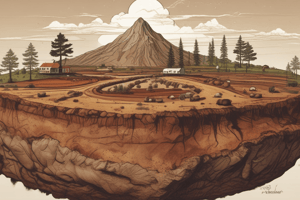Podcast
Questions and Answers
What is the primary difference between soil texture and soil structure?
What is the primary difference between soil texture and soil structure?
Soil texture refers to the proportion of different sized particles, while soil structure refers to the arrangement of those particles.
What type of clay particles have the greatest capacity for ion exchange?
What type of clay particles have the greatest capacity for ion exchange?
Colloidal clay particles
What is the main difference between capillary water and gravitational water?
What is the main difference between capillary water and gravitational water?
Capillary water is held in pores and is available for plant uptake, while gravitational water is moved by gravity and is only temporarily available to plants.
What is the composition of loam soil in terms of sand, silt, and clay?
What is the composition of loam soil in terms of sand, silt, and clay?
What is the primary advantage of sandy soils?
What is the primary advantage of sandy soils?
What is the primary disadvantage of clay soils?
What is the primary disadvantage of clay soils?
What is the product of the breakdown of organic matter?
What is the product of the breakdown of organic matter?
What is the approximate percentage of pore space in soil?
What is the approximate percentage of pore space in soil?
What is the main factor that determines the soil texture?
What is the main factor that determines the soil texture?
What is the term for the pores within the floccule in soil structure?
What is the term for the pores within the floccule in soil structure?
What is the main consequence of soil compaction on soil structure?
What is the main consequence of soil compaction on soil structure?
What is the term for the water held in the pores within the soil aggregates and in the pores between the soil aggregates?
What is the term for the water held in the pores within the soil aggregates and in the pores between the soil aggregates?
What is the significance of soil colour in relation to fertility?
What is the significance of soil colour in relation to fertility?
How does temperature affect seed germination and plant water uptake?
How does temperature affect seed germination and plant water uptake?
What is the result of erosion, sedimentation, and weathering on soil structure?
What is the result of erosion, sedimentation, and weathering on soil structure?
What is the term for the water that is held in a thin layer around the soil particle due to its polarised nature?
What is the term for the water that is held in a thin layer around the soil particle due to its polarised nature?
Flashcards are hidden until you start studying
Study Notes
Physical Properties of Soil
- Soil texture is a measure of the proportion of different sized particles (sand, silt, clay) in a soil sample.
- Soil structure is the arrangement of soil particles in a soil.
Particle Size and Soil Types
- Mineral matter is derived from parent material and is classified by size.
- Soil types:
- Sandy soils: large air pores, free draining, easy to work with, but dries out quickly and has poor nutrient retention.
- Clay soils: holds water easily, fertile, but has poor drainage and can lead to waterlogging.
- Loam soil: a soil that contains equal amounts of sand, silt, and clay, with intermediate characteristics of clay and sandy soils.
Organic Matter
- Humus is the product of the breakdown of organic matter (humification).
- Humus is a dark, sticky material that absorbs water, improves soil structure, and is rich in nutrients.
Soil Texture and Drainage
- The breakdown of the parent rock impacts soil texture, making it a fixed property of soil that cannot be changed.
- The ratio of sand, silt, and clay determines the soil texture.
- Methods to determine soil texture include hand testing, sedimentation, and soil sieve analysis.
Soil Structure
- Key points for soil structure:
- Good structure is necessary for healthy plant growth, nutrient availability, and microbial activity.
- Floccules contain micropores, while pores between adjacent floccules are larger and called macropores.
Impact of Various Factors on Soil Structure
- Factor 1 – Soil Compaction:
- Destroys soil structure.
- Reduces pore space, drainage, and aeration.
- Plant roots cannot penetrate soil, reducing growth.
- Less soil organisms (e.g., worms).
- Factor 2 – Organic Matter Loss:
- Poorer structure.
- Less nutrient availability.
- Lower water retention.
- Lower CEC (cation exchange capacity).
- Factor 3 – Erosion, Sedimentation, and Weathering:
- Loss of OM-filled topsoil.
- Sediments can put water quality at risk by carrying excess nutrients (manure) and pathogens.
Soil Water
- Water is held in soil as it is attracted to the negative charges of the clay particle.
- Water forms a thin layer around the soil particle, known as hygroscopic water.
- Capillary water: held in pores within and between soil aggregates.
- Gravitational water: moved through the soil by gravity, available on a temporary basis to plants.
Soil Colour
- Dark brown, black colour: rich in humus, highly fertile soils, and nutrient rich.
- Light colour or grey soils: low fertility, low in nutrients, lacking in humus, and suffers from leaching.
Soil Temperature
- Lower temperature results in lower germination.
- Lower temperature results in lower water and mineral uptake.
Studying That Suits You
Use AI to generate personalized quizzes and flashcards to suit your learning preferences.




